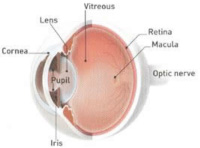Vitrectomy
A vitrectomy operation is surgery that removes some or all of the vitreous humour/gel (jelly like substance) from the back of the eye.
In some cases the cavity is refilled with fluid. In a number of vitrectomy operations on air/gas exchange is also performed where gas is injected into the posterior part of the eye. The gases then act to hold the retina in place.

The gas is reabsorbed by the eye over a period of time (air approximately 1 week, gas may take up to 2 months). It is replaced with a clear aqueous fluid produced by the eye. When the eye is filled with gas, the vision is very poor. As the gas bubble becomes smaller, the patient will see it shrinking towards the bottom of the eye - a bit like looking through a spirit level.
Finally the gas will break up into smaller bubbles, which appear as black dots in their vision. Eventually it will disappear completely. It is important that patients do not fly until the gas bubble has completely disappeared as the reduced atmospheric pressure can cause the gas to expand, increasing the pressure inside the eye to dangerous levels.
Gas exchange vitrectomies are used for a number of conditions but most regularly for treatment of Macular Holes and Macular Pucker. They can also be used in patients who have retinal detachment, age related macular degeneration and sub-macular haemorrhages to name a few.

